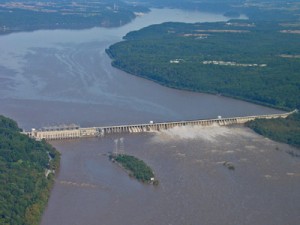
At the head of the Chesapeake Bay Watershed is the Susquehanna River. Flowing more than 400 miles, it is the longest Atlantic U.S. river and one of North America’s largest rivers.
The river drains 27,500 square miles, including parts of Pennsylvania, New York, and Maryland.
The Susquehanna originates in upstate New York as the North Branch. The West Branch, which begins in western Pennsylvania, converges with the North Branch near Northumberland, Pa.
On the lower stretch of the river, a reservoir system consisting of Lake Clarke, Lake Aldred, and Conowingo Reservoir is formed by three consecutive hydroelectric dams. Safe Harbor Dam forms Lake Clarke. Holtwood Dam, the smallest of the three, forms Lake Aldred. The largest and most downstream dam, Conowingo Dam, forms Conowingo Reservoir.
Below the Conowingo Dam, the river widens at the Susquehanna Flats, one of the bay’s most unique habitats. The area contains an abundance of shallow water with a mix of submerged aquatic vegetation, and sandy or muddy flats.
Water clarity and salinity varies considerably in the Susquehanna Flats, depending on weather, river flow, and other factors. Below the Susquehanna Flats, the Chesapeake Bay becomes a higher salinity estuary.
Related Information